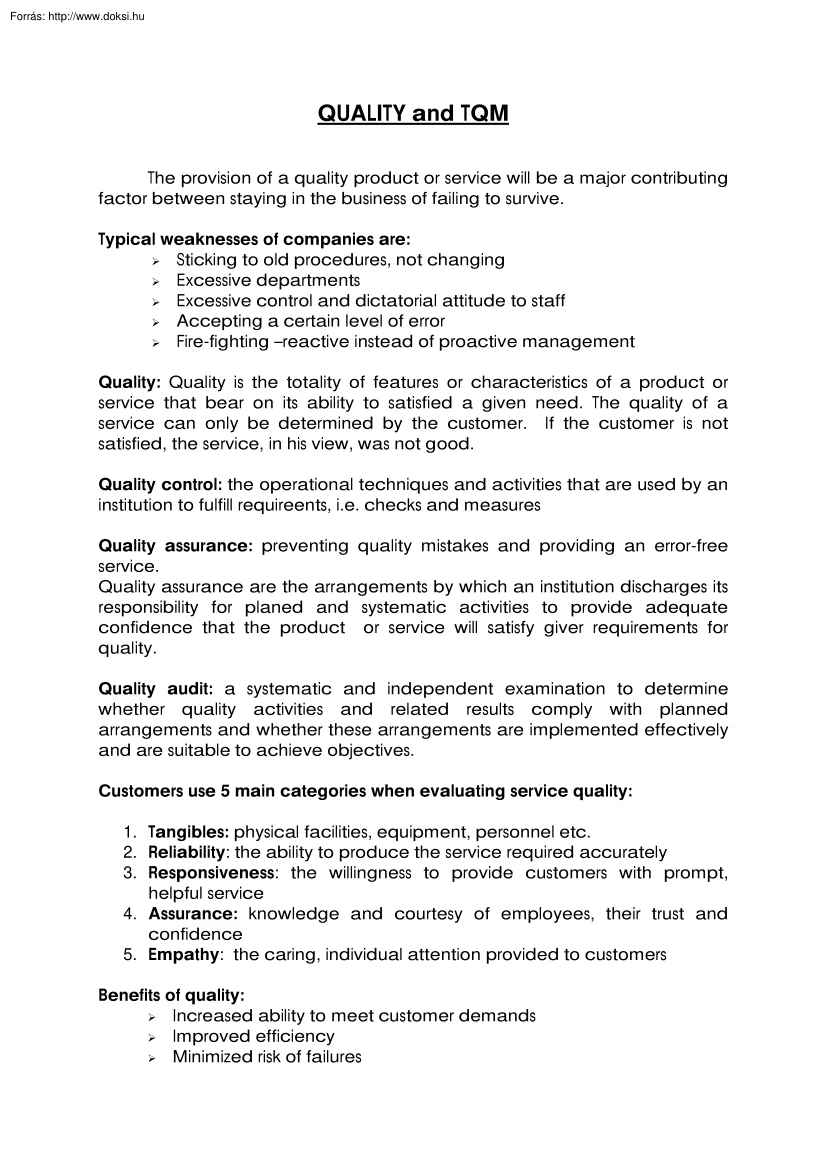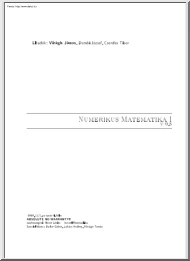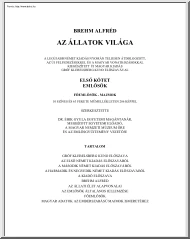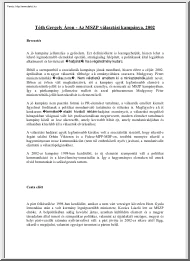A doksi online olvasásához kérlek jelentkezz be!

A doksi online olvasásához kérlek jelentkezz be!
Nincs még értékelés. Legyél Te az első!
Tartalmi kivonat
QUALITY and TQM The provision of a quality product or service will be a major contributing factor between staying in the business of failing to survive. Typical weaknesses of companies are: Sticking to old procedures, not changing Excessive departments Excessive control and dictatorial attitude to staff Accepting a certain level of error Fire-fighting –reactive instead of proactive management Quality: Quality is the totality of features or characteristics of a product or service that bear on its ability to satisfied a given need. The quality of a service can only be determined by the customer. If the customer is not satisfied, the service, in his view, was not good. Quality control: the operational techniques and activities that are used by an institution to fulfill requireents, i.e checks and measures Quality assurance: preventing quality mistakes and providing an error-free service. Quality assurance are the arrangements by which an institution discharges its
responsibility for planed and systematic activities to provide adequate confidence that the product or service will satisfy giver requirements for quality. Quality audit: a systematic and independent examination to determine whether quality activities and related results comply with planned arrangements and whether these arrangements are implemented effectively and are suitable to achieve objectives. Customers use 5 main categories when evaluating service quality: 1. Tangibles: physical facilities, equipment, personnel etc 2. Reliability: the ability to produce the service required accurately 3. Responsiveness: the willingness to provide customers with prompt, helpful service 4. Assurance: knowledge and courtesy of employees, their trust and confidence 5. Empathy: the caring, individual attention provided to customers Benefits of quality: Increased ability to meet customer demands Improved efficiency Minimized risk of failures Reduced wastage (in
restaurant) Improved working conditions Increased staff morale and lower staff turn-over Increased business opportunities Development of image and reputation Hidden costs of poor quality: Bad publicity Staff turnover Enforcement inspection Loss of business Security Poor productivity Overtime Lack of supervision Arguments Duplication of efforts Low morale Inadequate Sick leave communications Poor training The measurements of service quality: Guest feedbacks and satisfaction We have to strive for the honest guest feedbacks not throwing away the critical ones Analyze the feedbacks and draw the appropriate conclusions from them Mystery tests: checks quality in hotel chains Compare service level in different categories Service quality improvements: Good recruitment Employee recognition Cross-trainings Change in personnel Customer care Rewarding system Change technical supply In
Hungary: send people for training or work experience abroad to get new ideas TQM IS ALL ABOUT: LEADERSHIP FROM THE TOP FOCUSING ON DELIGHTING AND EXCEEDING CUSTOMER EXPECTATIONS CONTINUOUS IMPROVEMENT IN ALL ASPECTS OF THE BUSINESS TEAM WORK TO BRING ABOUT QUALITY IMPROVEMENTS EFFECTIVE QUALITY ASSURANCE SYSTEMS TO ENABLE EMPLOYEES TO ’DO IT RIGHT FIRST TIME, ALL THE TIME’. TOTAL QUALITY MANAGEMENT Total Quality Management (TQM) is an all encompassing philosophy that involves and effects all aspects of a company and its business. It has been stated that the philosophy has an impact on all aspects of the life of an organization and its people. TQM moves beyond the focus of meeting specifications, document control, internal non-conformance and inspection, to an environment that encourages continuous improvement, innovation and an obsession with delighting customers by exceeding their expectations. The only true measure of success can be given by the
organization’s customers. The key to achieve a state of ’taken for granted’ is to develop an organizational culture totally dedicated to the customer whether they be external or internal. For organizations who adopt TQM, the distinction between employee and customer satisfaction is no longer valid: TQ means managing and serving the employees as well as the customer. TQM relies completely on the attitude, understanding and commitment of the organisation’s top managent to embrace the philosophy and incorporate it into everything they do. Training and education are vital, as the participation and the change in the behavior of management which are invariably required. Objectives and Principles of TQM: For TQ to bring about reach business improvements, it has to be applied throughout the whole organization from the top to the bottom. The top level managent must demonstrate clearly their commitment to TQM and that the issue of quality is a serious business concern which affects
all employees. Within all operating departments basic changes of attitude will be required if TQ is to succeed. If top management do not recognize and accept their responsibilities for the development and implementation of TQM, the chances of failure are high. Systems and techniques are important in TQM but they are not the main requirement. TQM is more concerned with attitudes of mind, teamwork, and a determination to do well all the time – in essence, a total commitment to delighting the customer and exceeding their expectations. Team members should be accountable for their own performance Continuous improvement. TQM is about changing attitudes and skills so that all work processes carried out by every individual in the chain of events are done ’right first time, right every time’. The introduction of a successful TQM program is based on three key elements: 1. Quality assurance systems Meeting and exceeding customer needs can rarely be achieved without the
development and implementation of a quality assurance program. The quality assurance program ensures that the objectives set out by the management, often documented as the quality policy, are achieved at every time. 2. Quality tools and techniques TQM requires that the process should be improved continually by reducing any variations to set standards. This can be achieved by studying all aspects of the work processes and constantly searching for ways to improve them. All processes can be monitors and compared by gathering and using data more effectively. Continuous improvement demands continuous education in and application of the tools of quality improvement. 3. Teamwork Teamwork is essential for TQM. Teamwork throughout any organization is an essential component of TQM since it builds up trust and improves communication. The benefits of teamwork: Being able to tackle a greater variety of problems The opportunity to harness a pool of knowledge and expertise Developing and
building on ideas and suggestions more easily Generating more diverse ideas A more rewarding and fun process. Efforts of team members should be recognized. Worth should be generated. Implementing TQM: Points which form the basis for moving forward: Total commitment to continuous improvement The requirement to ’do it right first time’ Understanding the customer-supplier relationship Recognition that improvement of systems must be managed A commitment to ongoing education and training. The integration of tea work and the improvement of communication The development of a systematic approach to the implementation of TQM. The requirements needed to proceed must be discussed carefully and the reasons for implementing TQM established. Key steps that should be taken in the process of adopting TQM: Clear objectives – well communicated, clear mission statement and commitment to these objectives Clear plan of action with everybody’s
involvement and early commitment Choosing effective management structure Understand your customer requirements, need and expectations Do all jobs right at first time Introduce a quality assurance system Include team work Use right tools sand techniques Continuous improvement Three distinctive phases organizations go though in adopting TQM: 1. Phase: Survival Recognizing competitive threat and the need for improvement Isolating key problems Organizing to solve these Solving these problems 2. Phase: Prevention phase Bringing the business under control Management ownership Challenging existing roles and methods Building quality into the business Developing capable and motivated staff 3. Phase: Continuous improvement Business and integrated process Total customer orientation Fully participate management Controlled improvement and change is the norm
responsibility for planed and systematic activities to provide adequate confidence that the product or service will satisfy giver requirements for quality. Quality audit: a systematic and independent examination to determine whether quality activities and related results comply with planned arrangements and whether these arrangements are implemented effectively and are suitable to achieve objectives. Customers use 5 main categories when evaluating service quality: 1. Tangibles: physical facilities, equipment, personnel etc 2. Reliability: the ability to produce the service required accurately 3. Responsiveness: the willingness to provide customers with prompt, helpful service 4. Assurance: knowledge and courtesy of employees, their trust and confidence 5. Empathy: the caring, individual attention provided to customers Benefits of quality: Increased ability to meet customer demands Improved efficiency Minimized risk of failures Reduced wastage (in
restaurant) Improved working conditions Increased staff morale and lower staff turn-over Increased business opportunities Development of image and reputation Hidden costs of poor quality: Bad publicity Staff turnover Enforcement inspection Loss of business Security Poor productivity Overtime Lack of supervision Arguments Duplication of efforts Low morale Inadequate Sick leave communications Poor training The measurements of service quality: Guest feedbacks and satisfaction We have to strive for the honest guest feedbacks not throwing away the critical ones Analyze the feedbacks and draw the appropriate conclusions from them Mystery tests: checks quality in hotel chains Compare service level in different categories Service quality improvements: Good recruitment Employee recognition Cross-trainings Change in personnel Customer care Rewarding system Change technical supply In
Hungary: send people for training or work experience abroad to get new ideas TQM IS ALL ABOUT: LEADERSHIP FROM THE TOP FOCUSING ON DELIGHTING AND EXCEEDING CUSTOMER EXPECTATIONS CONTINUOUS IMPROVEMENT IN ALL ASPECTS OF THE BUSINESS TEAM WORK TO BRING ABOUT QUALITY IMPROVEMENTS EFFECTIVE QUALITY ASSURANCE SYSTEMS TO ENABLE EMPLOYEES TO ’DO IT RIGHT FIRST TIME, ALL THE TIME’. TOTAL QUALITY MANAGEMENT Total Quality Management (TQM) is an all encompassing philosophy that involves and effects all aspects of a company and its business. It has been stated that the philosophy has an impact on all aspects of the life of an organization and its people. TQM moves beyond the focus of meeting specifications, document control, internal non-conformance and inspection, to an environment that encourages continuous improvement, innovation and an obsession with delighting customers by exceeding their expectations. The only true measure of success can be given by the
organization’s customers. The key to achieve a state of ’taken for granted’ is to develop an organizational culture totally dedicated to the customer whether they be external or internal. For organizations who adopt TQM, the distinction between employee and customer satisfaction is no longer valid: TQ means managing and serving the employees as well as the customer. TQM relies completely on the attitude, understanding and commitment of the organisation’s top managent to embrace the philosophy and incorporate it into everything they do. Training and education are vital, as the participation and the change in the behavior of management which are invariably required. Objectives and Principles of TQM: For TQ to bring about reach business improvements, it has to be applied throughout the whole organization from the top to the bottom. The top level managent must demonstrate clearly their commitment to TQM and that the issue of quality is a serious business concern which affects
all employees. Within all operating departments basic changes of attitude will be required if TQ is to succeed. If top management do not recognize and accept their responsibilities for the development and implementation of TQM, the chances of failure are high. Systems and techniques are important in TQM but they are not the main requirement. TQM is more concerned with attitudes of mind, teamwork, and a determination to do well all the time – in essence, a total commitment to delighting the customer and exceeding their expectations. Team members should be accountable for their own performance Continuous improvement. TQM is about changing attitudes and skills so that all work processes carried out by every individual in the chain of events are done ’right first time, right every time’. The introduction of a successful TQM program is based on three key elements: 1. Quality assurance systems Meeting and exceeding customer needs can rarely be achieved without the
development and implementation of a quality assurance program. The quality assurance program ensures that the objectives set out by the management, often documented as the quality policy, are achieved at every time. 2. Quality tools and techniques TQM requires that the process should be improved continually by reducing any variations to set standards. This can be achieved by studying all aspects of the work processes and constantly searching for ways to improve them. All processes can be monitors and compared by gathering and using data more effectively. Continuous improvement demands continuous education in and application of the tools of quality improvement. 3. Teamwork Teamwork is essential for TQM. Teamwork throughout any organization is an essential component of TQM since it builds up trust and improves communication. The benefits of teamwork: Being able to tackle a greater variety of problems The opportunity to harness a pool of knowledge and expertise Developing and
building on ideas and suggestions more easily Generating more diverse ideas A more rewarding and fun process. Efforts of team members should be recognized. Worth should be generated. Implementing TQM: Points which form the basis for moving forward: Total commitment to continuous improvement The requirement to ’do it right first time’ Understanding the customer-supplier relationship Recognition that improvement of systems must be managed A commitment to ongoing education and training. The integration of tea work and the improvement of communication The development of a systematic approach to the implementation of TQM. The requirements needed to proceed must be discussed carefully and the reasons for implementing TQM established. Key steps that should be taken in the process of adopting TQM: Clear objectives – well communicated, clear mission statement and commitment to these objectives Clear plan of action with everybody’s
involvement and early commitment Choosing effective management structure Understand your customer requirements, need and expectations Do all jobs right at first time Introduce a quality assurance system Include team work Use right tools sand techniques Continuous improvement Three distinctive phases organizations go though in adopting TQM: 1. Phase: Survival Recognizing competitive threat and the need for improvement Isolating key problems Organizing to solve these Solving these problems 2. Phase: Prevention phase Bringing the business under control Management ownership Challenging existing roles and methods Building quality into the business Developing capable and motivated staff 3. Phase: Continuous improvement Business and integrated process Total customer orientation Fully participate management Controlled improvement and change is the norm



